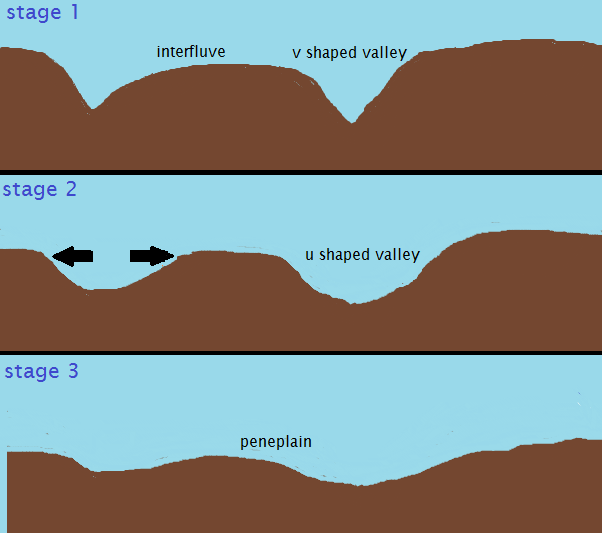Definitions
- Interfluve:
- Upland area between or separating valleys of adjacent watercourses.
- Drainage Divide
Imaginary line of higher ground separating different streams.
- Scarp
- A hard steep face of a slope, hill or valley uncovered by debris.
Landscape or slope evolution tries to explain how the landscape evolves and change with time. The way landscape is today is different to the way it was a million years ago.
Several geomorphologists particularly William Morris Davis, Walter Penck and Charles King tried to explain how slopes (the landscape) evolve over time.
The Davison Theory of Slope Decline (1889)
Davis was the first to envisage landscape evolution. He stated that landscape goes through stages; youth, maturity and old. These stages are known as geographic cycles.
Youth
In the youthful stage the landscape is characterised by interfluves (the land between two valleys of adjacent watercourses) and V shaped valleys. Upper course landforms such as waterfalls and rapids are most common. Stream divides are broad. The landscape is still young.
Maturity
In maturity stage lateral erosion by rivers wear down interfluves and valley sides becoming wider (U-shaped). Meanders start to develop and floodplains develop along the valley floor.
Old Stage
Characterised by flat and gently sloping terrains called peneplains and wide (U shaped valleys). Meanders and vast extensive floodplains are most common. Stream divides are not so sharp. Land area is near base level of erosion.
 Slope Decline
Slope DeclineThe Davisian theory was based on landscape in humid temperate regions. However, it was further applied to many regions like periglacial, deserts the tropics.
The Davison theory is good at explaining landscape evolution, however, its criticism lies in its simplicity and the elimination of tectonic processes.
His main focus was denudation and neglected the vital role tectonic activities such as faulting and uplift play in determining landscape form.
Penck’s Theory of Slope Replacement (1924)
Note
Penck’ theory was written in German e.g Primaörrumpf means the convex upper slope. Here we’re using the interpreted English terms.
Walther Penck’s focus was primarily on tectonic processes and denudation to determine landscape evolution.
According to Penck, the convex upper unit of slopes are formed when uplift is more pronounced than denudation (see diagram). The middle rectilinear unit has equal rates of uplift and denudation. The concave waning slope is dominated by denudation.
Penck then argued that steep scarps are gradually replaced and engulfed by a growing basal surface (the concave slope grows and replaces the rectilinear slope, the rectilinear slope grows and engulfs the scarp and convex slope). This causes the slope to become gentler.
Penck’s theory was subject to many criticism.
- Its complexity was linked to Davis’s simple theory of slope decline.
- The theory was misunderstood and misinterpreted by many because of its German language.
It failed to gain wide acceptance among geomorphologists and has been abandoned.
However, his inclusion of tectonic activities make it a significant theory to consider
 Slope Replacement: C replaces B, B then replaces A.Play
Slope Replacement: C replaces B, B then replaces A.PlayKing’s Theory of Parallel Slope Retreat (1957)
King envisaged that scarps retreat backwards leaving an extensive flat surface called a pediplain in the wake. As the scarps retreat, gently sloping extensions of hills or scarps called pediments are left which coalesce with time and forms the pediplain. The steep cliff is maintained as the scarp (slope) retreats backwards.
This theory mainly applies to coastal areas where sea waves erodes the base of a cliff and retreats back inland or areas with valleys and rivers in between causing the valley to retreat.
However, this theory does not apply to landscape where there is no sea eroding a cliff’s base or rivers wearing inland valleys.
He assumed a homogeneous terrain composed of the same rock type that retreats at the same rate which is not always the case.
The theory was undertaken on the plains of South Africa, hence it fails to fully support other regions.
Put less emphasis on tectonic processes

It is important to realise that no theory is widely accepted but it doesn’t mean the theory isn’t applicable. These and other geologists carried out their studies on particular locations e.g King in South Africa and the observations they discovered seemed to apply to that particular area, but failed to apply to other areas.
Conclusion
Each of these theories have their significance in understanding landscape evolution. There is no one size fit all theory. The landscape is dynamic and what one discovered in another area is not what the other found in another.
Reference: Fundamentals of Geomorphology (John Hugget)

